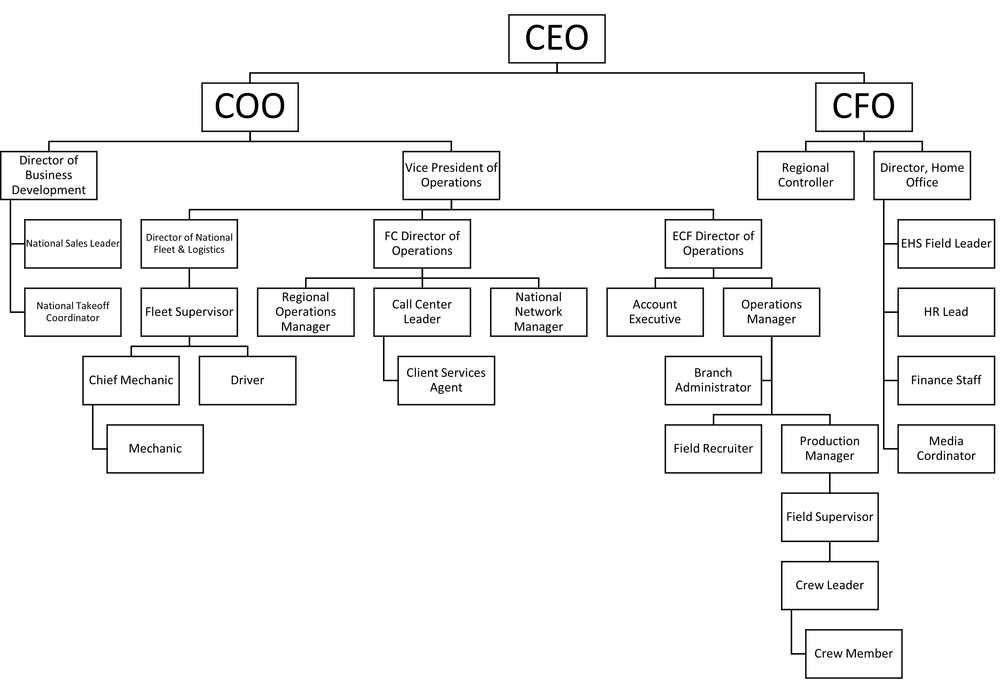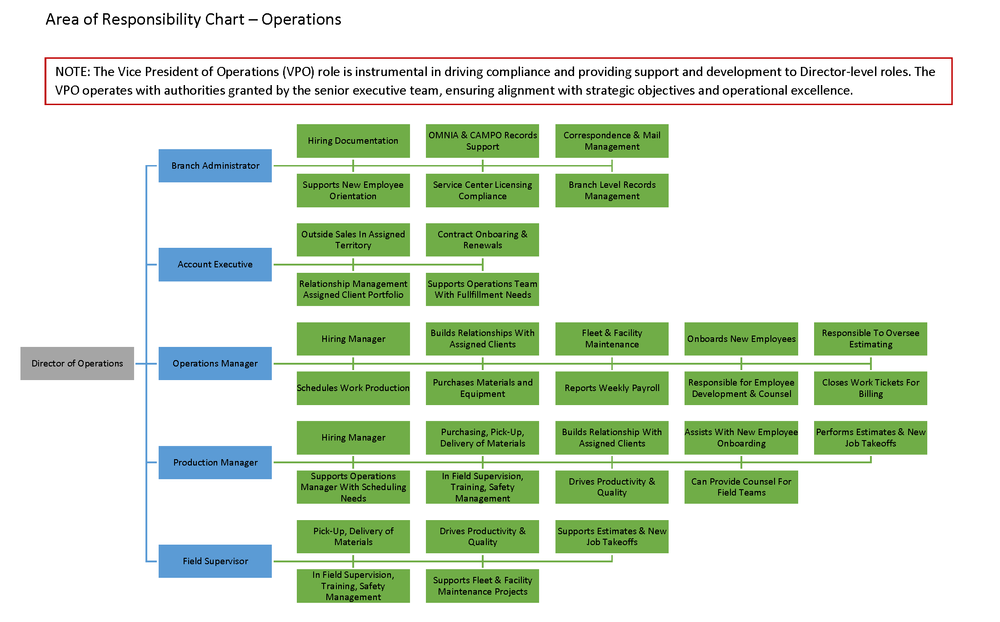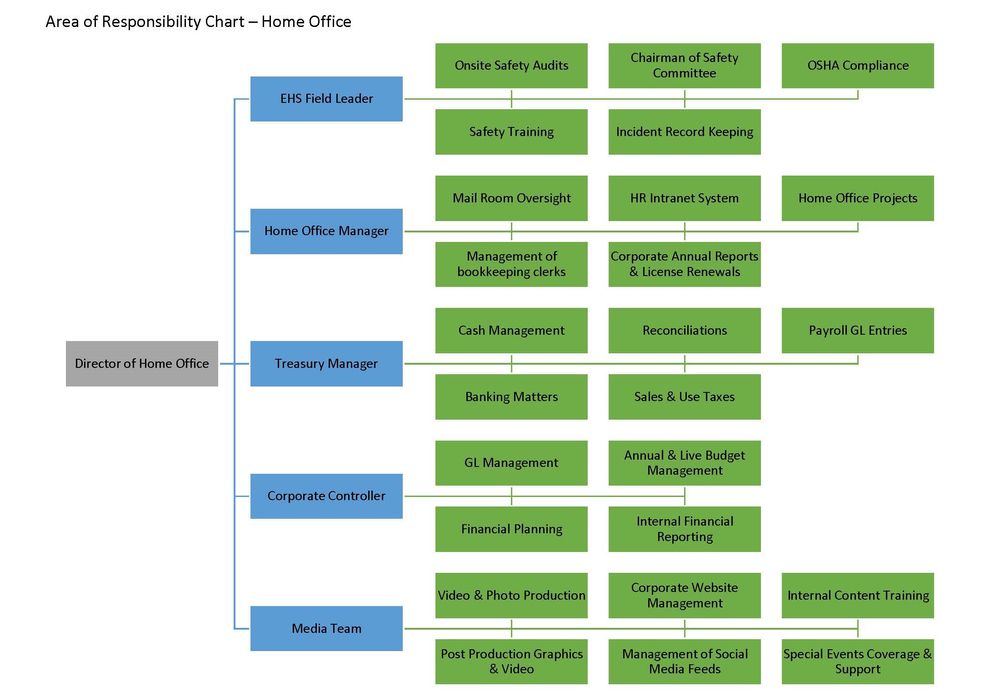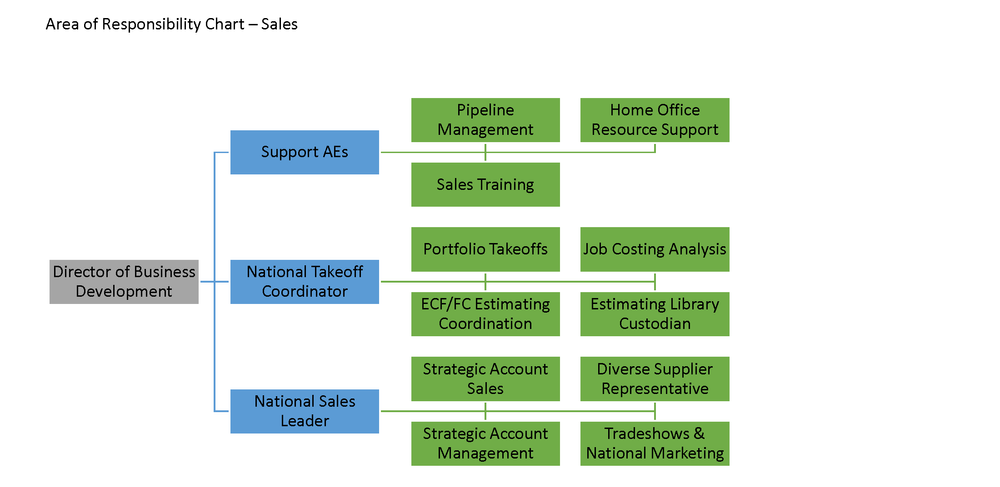What The Chain of Command Is Based On
East Coast Facilities (ECF) resembles a military precision organization (MPO) profile in the manner it operates. The MPO is hierarchical and operates under a highly controlled management model. To better understand this model, see the topic
What is ECF Culture But, here are some key takeaways for consideration:
- The MPO requires a hands-on senior management team.
- Everyone knows his or her role and implements it diligently.
- This highly efficient organization leverages its scale masterfully to execute large volumes of transactions.
- While it provides for a certain level of autonomy in the field, the military precision organization’s biggest ongoing challenge is preparing for growth beyond the tenure of its current leadership.
- In a military precision organization, when a colleague makes a commitment, people can count on it.
- Senior people “walk the talk” and deliver consistent messages.
- Autonomy is acceptable and encouraged so long as the company's policies and procedures are being followed.
The ECF chain of command (COC) is built to embody this organizational model, which tightly governs service delivery, customer experience, and workforce oversight. Please review the "
Our Business Model & Structure Guidance" package to understand better how the COC aligns with our overall.
The Basic Structure Of The COC
Below is an illustration of the basic structure of the COC. The exact setup of the organizational plan for a region will vary depending on its needs. For example, only heavy industrial snow markets have Fleet Supervisors and full heavy mechanical infrastructure. Only tropical markets with a heavy concentration of HOA or COA high-rise communities may need a Branch Administrator for essential client communication.


Vice President of Operations
The
Vice President of Operations (VPO) role drives compliance and provides support and development to Director-level roles. The VPO operates with authorities granted by the senior executive team, ensuring alignment with strategic objectives and operational excellence. During the transitional scaling of East Coast Facilities (ECF), Vice Presidents of Operations (VPOs) will have a dotted line of oversight over assigned regions and Directors. This structure allows for flexible and collaborative leadership, ensuring effective management and alignment with ECF's growth objectives. The Vice President of Operations is an executive-level role.
The Directors
The following section provides a focused view of Directors' roles and the organization of their business units. Directors collaborate closely with and take direction from a
Vice President of Operations (VPO) to effectively address employees' and customers' needs and interests. Together, they work to ensure that their business units are aligned with company goals and deliver high-quality service. Although there is defined ownership for various tasks and areas of responsibility, the business units are designed to execute projects using a team approach.
There are four established Director roles. They are the
Director of Home Office,
Director of Business Development,
Director of Operations, and
Director of National Fleet & Logistics. There is only one DHO and DNFL, but multiple DBDs and DOOs. Directors are considered a senior leadership role.
Director of Home Office (DHO)
The Director of Home Office (DHO) oversees all centralized and shared services provided by the home office to the company's business units. This includes finance, human resources, insurance programs, corporate purchasing, recruiting programs, training systems, and the media team. The DHO plays a crucial role in assisting the CFO with various compliance programs and systems, collaborating closely with each Director of Operations to ensure these services effectively support and enhance business unit performance.
Director of Business Development (DBD)
The Director of Business Development (DBD) focuses on two key aspects of business growth. First, the DBD acts as a safety net for client retention by overseeing client satisfaction surveys and managing large, multi-state strategic accounts. This ensures that clients remain satisfied and engaged. Second, the DBD drives new business development by directly overseeing national sales leaders, whose primary role is cultivating and identifying new business opportunities.
In addition to these responsibilities, the DBD supports the business units of each assigned Director of Operations (DOO) by working closely with Account Executives. The DBD assists Account Executives with external sales activities, ensuring they operate efficiently and utilize company resources, including our proprietary CRM software. The DBD actively participates in and supports weekly sales meetings for each business unit in their division. Importantly, the DBD serves as an ally to the DOO, working collaboratively to achieve shared goals rather than as an adversary.
Director of Operations (DOO)
The Director of Operations (DOO) holds full Profit and Loss (P&L) responsibility for their business unit. They are accountable for all sales activities within their region and the management of employees, equipment, real estate, and general infrastructure necessary to support these sales. The DOO collaborates closely with the Director of Home Office (DHO) and the Director of Business Development (DBD) to ensure seamless operations and strategic growth.
The DOO oversees the largest number of employees within the organization, bearing the significant responsibility of fostering their development in alignment with East Coast Facilities' (ECF) culture. This organizational structure places the DOO just four levels away from the front line, ensuring a close connection with the workforce. The DOO knows the appearance, names, ranks, strengths, weaknesses, goals, and dreams of their front-line staff. As a steward of the company’s mission statement, the DOO is committed to upholding the organization's values and driving its success.
Director of National Fleet & Logistics (DNFL)
The Director of National Fleet & Logistics (DNFL) is the key leader responsible for overseeing the management of our national equipment and vehicle fleet. This role encompasses the entire asset life cycle, including capital planning, delivery, maintenance, remanufacturing, and disposal. The DNFL directly oversees all requests related to new fleet acquisitions, fleet transfers, disposals, and heavy maintenance projects. The primary objective of this role is to ensure the fleet operates efficiently and safely, maximizing its lifespan to minimize costs to the company.
The DNFL manages the Home Office "Fleet" business unit, which owns all equipment and vehicle fleet master leases and notes. When fleet assets are assigned, the Fleet business unit will back-charge each service center accordingly. These back charges will also cover any relevant labor, logistics, and hauling costs incurred by the Home Office Fleet (HOF) for fleet-related expenses. Preventative maintenance programs, installation and replacement of wearable parts, and light repairs are handled at the service center level and are not directly managed by the DNFL. However, the DNFL may review these activities for compliance since they impact the fleet life cycle.
The DNFL and DOO roles collaborate closely to drive efficiency and ensure compliance with fleet maintenance and repairs. As the DOO is responsible for their business unit(s) and has P&L accountability, effective cooperation with the DNFL is essential. In turn, the DNFL must align with the needs of each DOO to provide support and ensure overall compliance with company policies and procedures. Any misalignment between the DNFL and DOO will be addressed and resolved by the VPO or DHO role.
Mission Statement
Deliver best in class facility maintenance services to our clients through a powerful people-first business culture that protects and develops front line workers.
A Closer Look At Operations Teams
A Director of Operations (DOO) oversees one or more Service Centers along with any associated Satellites, collectively known as a Region. Notably, Regions in snow markets tend to generate higher revenues than those in transitional or sunbelt markets despite requiring significantly fewer full-time employees per million dollars in revenue. Recent internal statistics reveal that snow markets need only three full-time employees per million dollars sold, whereas tropical markets require 11 employees for the same revenue. This discrepancy is largely due to the inherent nature of snow removal, which involves higher gross margins due to increased risk, volatility, and substantial fleet expenses. In contrast, southern markets experience less risk and volatility but demand greater oversight and manpower per million dollars sold.
Each business unit has its own strengths and weaknesses; however, both contribute to the master plan of achieving diversified revenues. Understanding the differences between snow and sunbelt markets enables Directors to staff their business units appropriately based on the market they serve and the volume of business managed. This strategic approach ensures that the workforce is optimally aligned with market demands, enhancing operational efficiency and profitability.
Roles Reporting To The DOO
Roles that are in business units led by the DOO include the
Branch Administrator,
Operations Manager,
Account Executive,
Production Manager,
Field Supervisor,
Crew Leader, and
Field Technician. Each of these roles also has a Senior alternate. This designation indicates a team member who is very experienced in executing the role. They usually have more years of service and are paid higher wages. Some "Seniors" have special licensing or education that brings additional value to the company.
New sales, customer service, and fulfillment responsibilities are consolidated under the Director of Operations (DOO). This strategic alignment ensures that customers receive prompt and efficient service, as one leader oversees the commitment to customer satisfaction and the execution of that commitment by the Operations team. Achieving a balance between exceptional customer service and efficient service delivery is essential. Below is an illustration of how the Operations team and Sales personnel collaborate to uphold our standards of dynamic service and superior customer experience.

How We Tackle Customer Service & Service Delivery

A Deep Dive Into a "Service Point of Contact"
You will notice a responsibility the Operations team carries, called "Service Point of Contact". What does this mean? The Account Executive is responsible for maintaining the relationship with a client, but the Operations is responsible for delivering service. Who then does an existing customer contact for service requests? The short answer is it depends on the needs of the customer. It is important to remember that not every customer serviced by East Coast Facilities looks like your customer. Consider these customer types:
The Remote Corporate Buyer
These customers are the most hands-off and disconnected type of customer. No news is good news for them, and as long as their stakeholders are happy, we are on cruise control. ECF delivers tens of millions of dollars of business to this customer profile. We negotiate a service agreement, close the sale, turn the contract over to operations, and begin service delivery. When customers need something, they email them to whatever email address they were provided. There is little to no emotion involved in this type of trading.
The Onsite Facility Manager
The onsite Facility Manager is often a stakeholder or an influencer, not a decision-maker. The contract was sold and negotiated with a Corporate Buyer, usually off-site. However, this onsite stakeholder still needs a point of contact, which may differ from the Corporate Buyer's needs. Operations should provide a name, phone number, and email as a point of contact. Production Managers and Field Supervisors should check in with the Facility Manager when onsite to train or oversee projects and production. Usually, the Account Executive is hands-off with this role but may still engage them if necessary.
A Third Party Commerical Portfolio Property Manager
This profile buyer is more hands-on. They answer to an owner, usually an investment group. They are not on-site; for them, no news is good news. They are busy and not usually too needy. A name, phone number, and email as a point of contact to route requests are also fine for them. They will rely on Operations to inspect the property and provide advice on remedial and enhancement opportunities to various areas of facility maintenance. They are receptive to proposals from the Operations team and usually transact many decisions via email. The owner's representative, usually an asset manager, governs their decisions. So, they do not have exclusive authority to approve contracts and proposals.
An Owner Operator Commerical Portfolio Property Manager
This profile is very similar to that of a third-party commercial portfolio manager. The major difference is that they do not answer to an owner. They are the owner. They can make fast decisions and are less needy than the Third-Party profile because they answer to no one. They need a name, phone number, and email as a point of contact to route requests through. Usually, they make many decisions via email.
The Onsite Commercial Property Manager
Onsite commercial property management is not very common. When it exists, it is usually a complex property. This client requires more than simple contact information; they require a face. Often, they want Crew Leaders to check in when onsite, sometimes signing a ledger. Production Managers supervising projects or production at the site should check in a while on site, even if several different Production Managers are active on-site at various times. This customer has one point of contact with the operations team but has become used to our team approach to executing production. It is wise to schedule regular walk-throughs with the Property Manager, Account Executive, and a member of the Operations Team.
A Residential Portfolio Manager
Everything changes as soon as you enter the word residential into the picture. The needs and requirements of this client profile, figuratively speaking, go through the roof. The Residential Manager profile is a stakeholder or an influencer, not a decision-maker. This client needs a specific person as a point of contact who knows all of the customer's pending work orders and service requests. This person is almost always an Operations Manager or a Production Manager. If the property or portfolio being serviced is large, the customer will often be given a shared email address, such as BSCclientservices@eastcoastfacilities.com. The home office can create these types of email addresses if needed. If the designated point of contact is the Production Manager, he/she must inform the Operations Manager of all correspondence, service requests, or issues with the property or portfolio. This is because the Production Manager is not the only Production Manager working on-site delivery services. Other Production Managers in other services and teams will likely be onsite. Weekly operations meetings are a great time to collaborate on the needs of residential customers. It is wise to schedule regular walk-throughs with the Property Manager, Account Executive, and the assigned point of contact for the Operations Team. If the property or portfolio is very large, the DOO will be closely involved in matters of service delivery.
A Residential Board Member
Board Members for community associations can be very hands-on or very hands-off. There is no precedent either way. But when they are "hands-on", they are usually "HANDS-ON". The Board Member profile is a stakeholder or an influencer, not a decision-maker. But, certain Board Members can control a board and ultimately be the decision-maker. Or, a small group of Board Members representing a quorum can control a board and ultimately be the decision-maker. Operations must be vigilant to the needs of this customer profile. There is no exact answer to this profile's point of contact assignments. The Director, Account Executive, and Operations Manager should discuss what contacts are appropriate to give to a single board member, but be mindful that they do not alienate other customer stakeholders.
The Important Role Of The Operations Manager
A very important reminder for the Operations and Sales teams to remember is that the Operations Manager is the key to the "Point of Contact" model. He is like a quarterback who directs all the players on the field. He, under the supervision of the DOO, ultimately calls the plays. He keeps the team moving down the field because he oversees all operations, middle managers, personnel, and equipment. He is responsible for the master schedule. Every customer point of contact must keep the Operations Manager up to date at all times so he can quarterback the team properly. He is the hub, and everyone else is a spoke. The operations manager works hard to communicate well with the operations and sales teams. For this reason, it is best to limit the Operations Manager as a point of contact unless it makes sense to assign him to a certain property or project.
Some operations managers have a branch administrator. The Branch Administrator is the assistant to the Operations Manager and helps him/her with internal and external correspondence. The branch administrator is also occasionally assigned various projects related to the operations team. Large business units may need a branch administrator. The President will approve this position on a case-by-case basis.
Front Line Workers
Front-line workers include
Crew Leaders (CL) and
Technicians (FT). The chart below illustrates the COC.

CLs report directly to Production Managers (PM) and are supported by Field Supervisors (FS). FS' are not managers. There are two distinct differences between the roles of a PM and FS. Namely, PMs have hiring authority under the supervision of an Operations Manager. PMs can also "write up" front-line workers using the company's citation system. FS' does not have hiring authorities and cannot discipline front-line workers. They may only coach them, verbally correct them, and bring uncorrected matters to the attention of the PM.
Technicians report to CLs. Therefore, it is important to keep crews together as consistently as possible. A technician constantly changing from one crew to the next will not have the opportunity to be developed as he/she will be under a specific CL. Also, technicians constantly moving from one CL to another cannot be properly rated during performance reviews.
Front-line workers are the key to our mission. All leaders should be trained on ECF Culture to be best equipped and empowered to ensure our front-line workers get the attention and development they deserve.
Roles Reporting To The DHO
The roles of the Home Office team include
Home Office Manager,
Banking and Treasury Manager,
AR Clerk,
AP Clerk,
Controller,
EHS Field Leader, and the
Brand and Media Coordinator.
Major Areas Of Responsibility For The Home Office Team

Roles Reporting To The Director of Business Development








